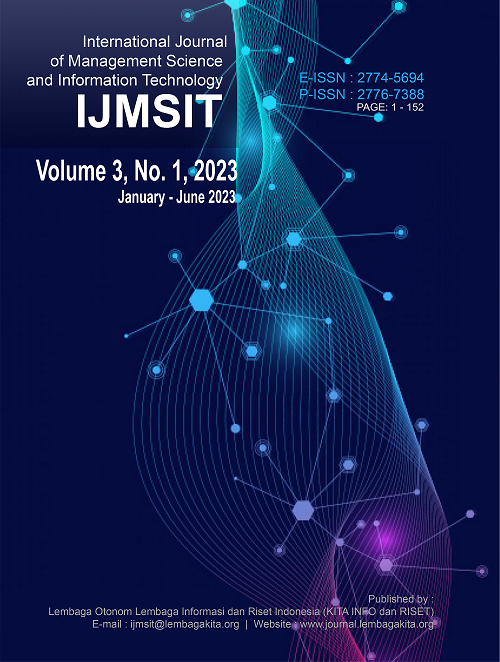Extending Education Shapes Student Behaviour in Entrepreneurship: The Mediating Role of Self-efficacy and Intention
DOI:
https://doi.org/10.35870/ijmsit.v3i1.946Keywords:
Behavior, Self-efficacy, Intention in entrepreneurshipAbstract
This study examines that the entrepreneurship education curriculum process requires other supports, such as self-efficacy and intention from internal students. As 461 respondents were gathered by convenience sampling from a total population of 530 students taking Sharia Entrepreneurship courses at a private Islamic university in Indonesia. Entrepreneurial education does not have a significant direct effect on the formation of entrepreneurial behavior. However, entrepreneurship education can provide motivation for entrepreneurial intentions and make students more self-aware about entrepreneurship. Only after the stages of self-efficacy and intention appear in students can they drive more profound entrepreneurial behavior. The existence of self-efficacy and entrepreneurial intentions is a way that is more reinforcing outside of education as a trigger for entrepreneurial behavior. This result is seen from the direct influence that is not significant between education and behavior; it is fully mediated by self-efficacy and intention. This indicates that entrepreneurial knowledge is only a source of knowledge. If students' internal factors do not support it, then education will only be mere information simply because it is a required subject for students to pursue. It is necessary to have the role of educational institutions to also look at other stimulus factors to shape entrepreneurial behavior, such as aspects of family, gender, passion, and other things that can activate entrepreneurial behavior.
Downloads
References
S. Van Scotter II & Garg, “Entrepreneurial Tenacity and Self-Efficacy Effects on Persisting Across Industry Contexts College of Business , University of Colorado Colorado Springs Indian Institute of Management,” vol. 15, no. 3, pp. 147–173, 2019, doi: 10.7903/cmr.19501.
K. Miller, A. Alexander, J. A. Cunningham, E. Albats, A. Alexander, and J. A. Albats, “Entrepreneurial academics and academic entrepreneurs: a systematic literature review) ‘Entrepreneurial academics and academic entrepreneurs: a systematic literature review,’” 2018.
J. Wijangga and E. L. Sanjaya, “The Relationship between Entrepreneurial Self-Efficacy and Entrepreneurial Intention among University Students,” pp. 19–24, 2019.
C. Highfield, K. Lee, and B. Hardie, “Entrepreneurship education today for students unknown futures,” J. Pedagog. Res., vol. 4, no. 3, pp. 401–417, Sep. 2020, doi: 10.33902/jpr.2020063022.
C. Elitha and D. E. Purba, “Entrepreneurial Self-Efficacy and Entrepreneurial Intention : The Mediating Role of Entrepreneurship Intentional Self-Regulation among Future Entrepreneurs,” vol. 23, no. 2, pp. 149–159, 2020, doi: 10.14414/jebav.v23i2.2239.ABSTRACT.
C.-C. Dragomir and S. Pânzaru, “THE RELATIONSHIP BETWEEN EDUCATION AND ENTREPRENEURSHIP IN EU MEMBER STATES,” vol. 22, no. 2, pp. 55–65, 2015.
D. Luh, C. Wu, and O. Huang, “Learning-to-Teach : A Case of Entrepreneurial Entrepreneurship Education in Taiwan,” pp. 3458–3473, 2022, doi: 10.4236/ce.2022.1311221.
Y. Buana, D. Hidayat, and B. Prayogi, “The Effect of Entrepreneurship Education on Entrepreneurial Intention of University Students by Adopting Linan Model,” vol. 8, no. May, pp. 67–75, 2017, doi: 10.21512/bbr.v8i1.1958.
Z. Peng, G. Lu, and H. Kang, “Entrepreneurial Intentions and Its Influencing Factors : A Survey of the University Students in Xi ’ an China,” vol. 3, no. December, pp. 95–100, 2012, doi: 10.4236/ce.2012.38b021.
A. B. N. Viana, L. C. Carvalho, and R. B. Cândido, “Global Considerations in Entrepreneurship Education and Training,” no. January, 2019, doi: 10.4018/978-1-5225-7675-4.ch001.
Downloads
Published
Issue
Section
License

This work is licensed under a Creative Commons Attribution-NonCommercial-NoDerivatives 4.0 International License.
Copyright and Licensing Agreement
Authors who publish with this journal agree to the following terms:
1. Copyright Retention and Open Access License
- Authors retain full copyright of their work
- Authors grant the journal right of first publication under the Creative Commons Attribution 4.0 International License (CC BY 4.0)
- This license allows unrestricted use, distribution, and reproduction in any medium, provided the original work is properly cited
2. Rights Granted Under CC BY 4.0
Under this license, readers are free to:
- Share — copy and redistribute the material in any medium or format
- Adapt — remix, transform, and build upon the material for any purpose, including commercial use
- No additional restrictions — the licensor cannot revoke these freedoms as long as license terms are followed
3. Attribution Requirements
All uses must include:
- Proper citation of the original work
- Link to the Creative Commons license
- Indication if changes were made to the original work
- No suggestion that the licensor endorses the user or their use
4. Additional Distribution Rights
Authors may:
- Deposit the published version in institutional repositories
- Share through academic social networks
- Include in books, monographs, or other publications
- Post on personal or institutional websites
Requirement: All additional distributions must maintain the CC BY 4.0 license and proper attribution.
5. Self-Archiving and Pre-Print Sharing
Authors are encouraged to:
- Share pre-prints and post-prints online
- Deposit in subject-specific repositories (e.g., arXiv, bioRxiv)
- Engage in scholarly communication throughout the publication process
6. Open Access Commitment
This journal provides immediate open access to all content, supporting the global exchange of knowledge without financial, legal, or technical barriers.












